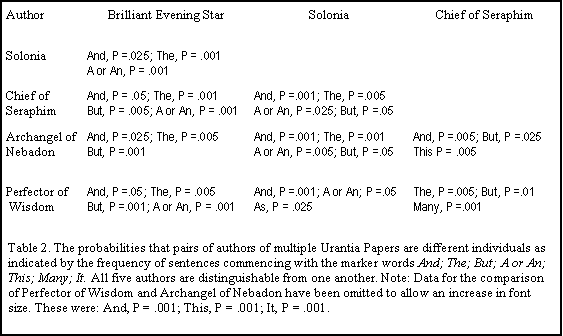|
The first investigation had the limited goal of deciding whether a single author wrote the book. The results (Table 1) were first printed in the Australian newsletter Six-O-Six, Vol. 13 (2), 1992 and indicated that there may have been in excess of nine authors. Later, my son, Paul, who has a Ph.D. in maths and statistics, suggested that a more rigorous investigation could be done for those authors to whom multiple papers were attributed. Such an analysis permitted the inclusion of estimates of variance both within and between authors. Five sets of four or more papers from five authors were chosen in which there was reasonable certainty that each set was attributable to the same author. The results for this investigation were printed in Six-O-Six, Vol 14 (3), 1993, and clearly distinguished between each of the five authors. Besides the data given in Table 2, a global likelihood ratio test in a logical regression analysis showed that for the marker word "And," the results indicated four or more authors at a probability level of 0.0003. For the marker word "The," three or more authors were indicated at a probability level of 0.0001.
Was Dr Sadler an author?
For the first investigation, in addition to attempting to demonstrate multiple authorship, an effort was made to throw light on whether Dr Sadler was the single author postulated by others. The only work of Dr Sadler then available to me in Australia was a short essay entitled, "Evolution of the Soul," in which about half of the text was direct quotation from The Urantia Book. The essay was too short to use the Mosteller and Wallace methods. However, after separating The Urantia Book text from the remainder, the two sections were subjected to a computerized style analysis program that provided scores on the basis of sentence length, sentence structure, and the Flesch Reading Ease Index. Each of these characteristics differentiated two distinct writing styles at statistically significant levels, thus indicating that Dr Sadler was not the author of The Urantia Book quotations from that essay.
The investigation on the involvement of Dr Sadler in the authorship of The Urantia Papers has come under some criticism on the basis of the small sample size of the essay, "Evolution of the Soul." In 1996, courtesy of Dr Matt Neibaur, I was provided with "The Mind at Mischief," a book published by Dr Sadler in 1929 that has permitted a more extensive investigation. I scanned a little more than fifty pages of this book, almost 20,000 words, into my computer, with which to test Dr Sadler's writing style against the data already accumulated for the Mosteller and Wallace type of investigation on authorship. The Sadler text material was converted into a FolioViews database, then tested against the data for those five Urantia Book authors accredited with multiple papers. From 37 tests, 35 distinguished between Dr Sadler and the Urantia Paper author at odds of 20 to 1 or better, 30 being at 100 to 1 or greater, and 14 being better than 1000 to 1. Only two of the tests failed to attain significance (less than 20 to 1).
The Urantia Book material quoted in Dr Sadler's aforementioned essay had been drawn from Papers 5, 110, and 111. Again using Mosteller and Wallace methodology, in two tests the Mind at Mischief sample was compared with these Papers and showed significant differences at the 100 to 1 and 1000 to 1 levels. In his book "Urantia: The Great Cult Mystery," Martin Gardner offered the opinion that Dr Sadler wrote Part 4 of The Urantia Book. To check this suggestion, a further two tests were made of the "Mind at Mischief" material against Papers 195 and 196 from Part 4 of the book with the result that both tests showed significant differences at the 1000 to 1 probability level.
It is a fact that some of the same unusual words and expressions are to be found in both the writings of Dr Sadler and in the Urantia Papers. This is hardly surprising since Sadler admitted to being continuously exposed to the content of the various Urantia Papers, or their precursors, certainly since 1911 and possibly since 1906, long before the final drafts of the Papers were completed.
|
|



